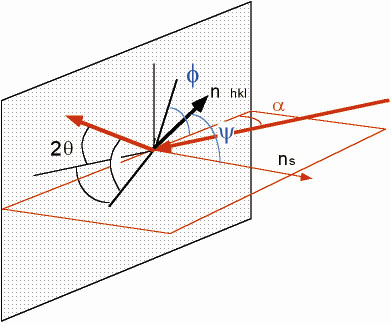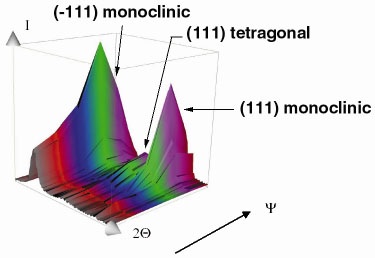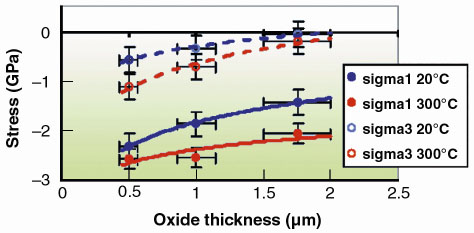- Home
- Users & Science
- Scientific Documentation
- ESRF Highlights
- ESRF Highlights 2001
- Materials
- Stress Measurements in Thin Films using Synchrotron Radiation
Stress Measurements in Thin Films using Synchrotron Radiation
The in situ determination of stress is an important application of X-ray diffraction in materials science. The measurement of strain along several directions allows the determination of different components of the strain tensor. However, when thin films are considered, these measurements can prove to be difficult because the weak intensity of the scattering prevents the accurate determination of the Bragg peak positions, which is the principal way of evidencing stresses in stiff materials. In addition, large anisotropies are usually expected in thin films depending on the orientation with respect to the surface.
The flux of synchrotron radiation and its small divergence are necessary for these kinds of measurements.Here we show that standard z-axis surface goniometers can be used with several advantages for stress measurements.
Needs for stress measurements in thin films appear in many areas of materials science ranging from nuclear industry to micro-electronics. The example below deals with zirconia thin films, formed on zirconium alloys used as fuel cladding materials in pressurised water reactors.
On the coolant (water) side, an oxide layer forms, made of both monoclinic and tetragonal zirconia. Due to the thermal insulating properties of this layer, control of the factors affecting its growth is technologically very important. The stresses in this layer are key parameters in the control of the corrosion rate: they might induce crack formation in the oxide, stabilisation of the normally unstable tetragonal zirconia and alter the diffusion rate of oxygen through the oxide. Many experiments have been performed at room temperature on thick oxides showing a high compressive stress in the gigapascal (GPa) range. If one wishes to measure the true stress level related to the oxidation mechanism, it is necessary to perform, an experiment at the temperature at which the oxides are grown (i.e. 300°C in our case) in order to avoid contributions from the different expansion coefficients of the oxide and the metal.
When one is interested in the first stages of oxide growth (thin films), the use of synchrotron radiation is necessary to have an intense and nearly parallel incident beam. This beam is projected into the oxide at a small angle of incidence to control the penetration depth and avoid illuminating the diffraction lines of the metal substrate. Simultaneously the wavelength can be adjusted to tune absorption and to increase the scattering angles.
The geometry used (Figure 132) has some analogy with a standard surface scattering experiment: the incident angle alpha is kept fixed while scanning the 2 angle at constant tilt angle
(
is the angle between the probed hkl planes and the normal to the sample). Rotating the sample around its normal also allows one to keep the azimuth angle
constant when 2
is scanned.
 |
Fig. 132: Geometry for strain measurements in grazing incidence conditions. |
A series of peaks recorded for different values of the tilt angle y are shown in Figure 133. The shifts of several Bragg peak positions as a function of the tilt angle are measured from these curves. When plotted as a function of sin2
, the strains exhibit a straight line which allow the determination of both in plane and perpendicular components of the strain tensor using the standard "sin2
" method.
 |
Fig. 133: Evolution of the Bragg lines as a function of the tilt angle. |
Knowing the elastic constants of the material, the stress can be obtained. It was shown in our case that the stress level in both direction (1 and
3) decreases as a function of the oxide thickness (see Figure 134).
 |
Fig. 134: Evolution of in-plane ( |
Among the results from such studies on zirconia thin films one should mention the evidence that:
- residual stresses in the GPa range are present in thin zirconia films at high temperature
- the stress levels decreases when the oxide grows
- cooling the sample back to room temperature induces a relaxation of several hundreds of MPa
References
[1] M. Parise, O. Sicardy and G. Cailletaud, J. Nucl. Mat., 256, 35-46 (1998).
[2] O.Sicardy, I Touet, F. Rieutord and J. Eymery, J. Phys IV, 10 (2000).
Principal publication and Authors
O. Sicardy (a), I. Touet (a), F. Rieutord (b) and J. Eymery (b), Journal of Neutron Research 9, 263-272 (2001).
(a) CEA-Grenoble, DRT/DEN, Grenoble (France)
(b) CEA-Grenoble, DSM/DRFMC Grenoble (France)



